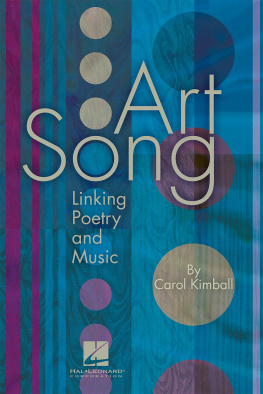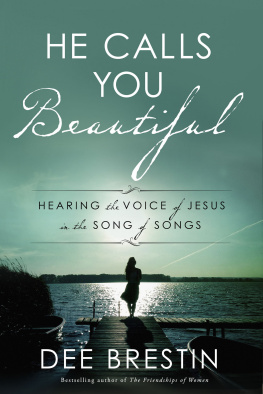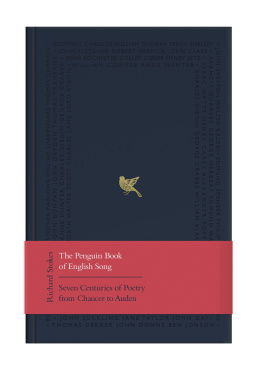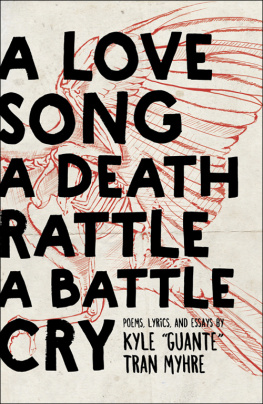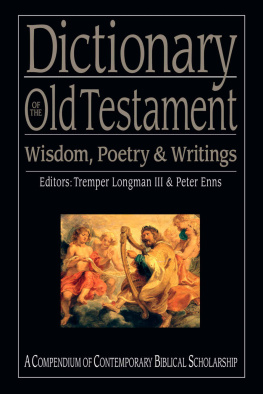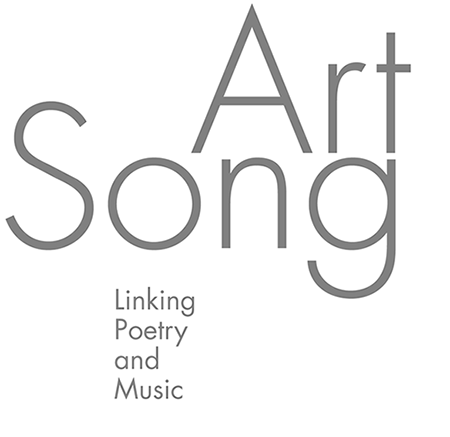ISBN 978-1-4803-5252-0
Copyright 2013 by Carol Kimball
All rights reserved. No part of this book may be reproduced in any form or by any electronic or mechanical means including information storage and retrieval systems without permission in writing from the publisher, except by a reviewer, who may quote brief passages in a review.
Hal Leonard Corporation
7777 W. Bluemound Rd.
P.O. Box 13819
Milwaukee, WI 53213
Library of Congress Cataloging-in-Publication Data
Kimball, Carol (Mezzo-soprano)
Art song : linking poetry and music / Carol Kimball.
pages cm
ISBN 978-1-4803-5252-0
1. Songs--Analysis, appreciation. 2. Songs--Interpretation (Phrasing,
dynamics, etc.) 3. Songs--History and criticism. I. Title.
MT120.K55 2013
782.42168--dc23
2013014322
Printed in the U.S.A.
Visit Hal Leonard Online at www.halleonard.com
Foreword
Bright is the ring of words
When the right man rings them
Fair the fall of songs
When the singer sings them.
Robert Louis Stevenson
In an art song recital the singer faces the ultimate challenge: to sustain an audiences interest by communicating drama, emotion, mood, and stories throughout a program of varied song styles and composers. During the course of the evening, the singer must play myriad roles and transmit numerous emotions and states of mind. The singer becomes a storyteller parexcellence: the link between the composer, the poet, and the listener. When the singer is able to draw the listener into the song on an emotionally responsive level, the ultimate artistic goal is achieved and he has ringed the ring of words.
In order to achieve this goal, singers have to do their research. They must plumb the depths of the poetry, be fastidious in their delivery of the words, and find the dramatic images and emotional moments submerged in the words they are singing. A precise approach on the singers part yields a performance rich in commitment and communication. Musical and technical details are key in this process. Gifted interpreters are usually addicted to the work of dissecting details of music and text in order to explore the layers of meaning that make up a songs totality, then bringing everything together again in performance.
Why write this book? My first book, Song: A Guide to Art Song Style and Literature, was a survey of art song repertoire and an overview of the history of art song in various countries. Art Song: Linking Poetry and Music book goes further than a broad overview of song literature. It deals fundamentally with what the art song genre is.
In my teaching and in numerous conversations with professional colleagues and university/college students over the years, I have become aware that though we work with song repertoire constantly, when performance time rolls around, many times the groundwork of preparing the entire song has been neglected. I have had young singers in master classes self-consciously read the poem they are about to sing or stumble over the poetic phrases with all the elegance of reading a grocery list. Often they cannot define lesser-known words found in the text. I doubt that every student takes every song they sing and dismantles its musical parts, exploring how the composer has re-created the poem as an art song.
So this book became a collection of thoughts on how to prepare an art song for performancewhat its basic parts are and how they merge to create the song itself, which links a poem to a musical setting by a composer. By understanding the component parts of an art song and studying how they complement and balance one another, singers can uncover details about the magical fusion created when words are linked to music.
As performing artists, we are in the business of creating and transmitting beauty. We need to be committed to working beyond memorizing notes and words. We must remain open to new and/or different ideas about performance and performance preparation. In the final analysis, our goal must be an honest re-creation of the song.
We especially need to work with poetry, which is the answer to the question Which came firstthe chicken or the egg? Singers need to fall in love with poetry and become fluent reading it. This step is quite often omitted or glossed over in performance preparation. The first section of the book explores how we can begin to read poetry and contains lists of poems that may be used for study and reading. There are also suggestions that might be helpful in becoming comfortable working with the texts we sing.
The musical score is the framework for the poemits partner and the other half of the art song equation. Studying the score and seeing how the composer has set the words in a musical context is vital to preparing song repertoire. Working with style is another important component of the preparation puzzle. Looking at the broad components or musical characteristics of the song and breaking them into smaller sub-headings can help us see how the composer has intuited the poem and has translated its imagery into sound.
The next section of the book centers on working with recital formats of differing designs and content, and discusses building recitals of varied, interesting, and engaging repertoire. The ideas presented here are intended to spark interest in working with repertoire in ways that will produce a committed, organic performance.
After all the preparation is completed, the songs we have worked on so diligently must be communicated to our listeners in performance. Our presentation must reflect our preparatory work, our vocal sound, and our artistic sensibilities.
Interpretation is an intangible word and shares a relationship to the singers emotional response in the moment of performance. Distinguished interpreter of the French mlodie and renowned teacher Pierre Bernac wrote: In the art of music, it is the interpreters performance which we come to regard as the work itself. 1 In order to produce imaginative and artistic performances, singers must have done extensive preliminary work with words and music. Then, armed with the knowledge that they have uncovered, abandon themselves in the moment of performance to being the final conduit for the voices of the poet and the composer.
The last chapter of the book is an annotated list of selected repertoire for undergraduate collegiate students. Three appendices follow, dealing with the recital program in print, a poetry poll of some professional musicians, and a selection of sample recital programs. Finally, there is an annotated bibliography organized by topics having to do with art song.
In todays fast-paced world, there are master classes, young artist programs, and all manner of summer programs, as well as books, articles, and videos that present ideas on performance preparation. This book contains some of my thoughts on the subject. Most of them are not new, but they are still workable suggestions for singers who care enough to adopt them. Hopefully these will cultivate renewed commitment to studying art song on the part of every singer whose goal in singing is artistry.
Carol Kimball
May, 2012
NOTES
1Pierre Bernac, The Interpretation of French Song

